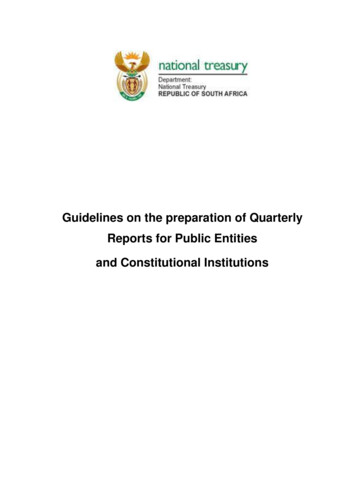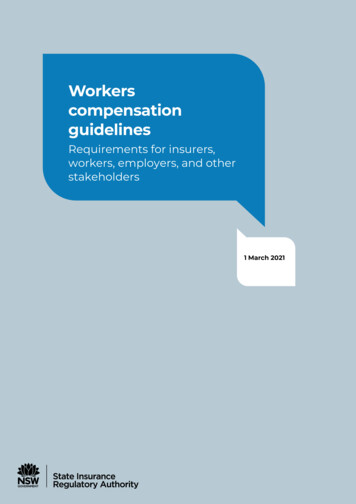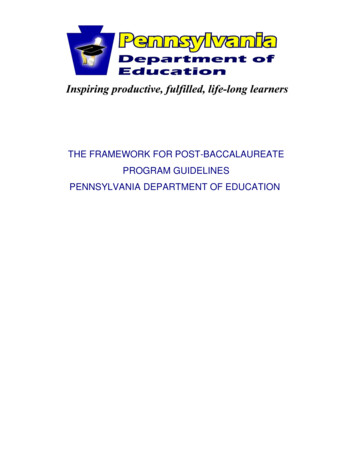
Transcription
Guidelines on the preparation of QuarterlyReports for Public Entitiesand Constitutional Institutions
CONTENTS1. INTRODUCTION32. BACKGROUND42.1. Current requirements for quarterly reporting . 42.2. Challenges under the current reporting system . 43. QUARTERLY REPORTING43.1. Database. 53.2. Programme/objective/activity information . 53.3. Performance indicators and targets . 53.4. Borrowings and guarantees . 63.5. Capital investment projects report . 63.6. Risk management . 73.7. Job creation. 73.8 Reporting timelines . 7ANNEXURE A: ADMINISTRATION PROGRAMME CONTENT82
1.INTRODUCTIONPublic entities are required to report on a quarterly basis to their ExecutiveAuthority. Treasury Regulation 5.3.1 requires the accounting officer of aconstitutional institution to establish procedures for quarterly reporting to theexecutive authority in order to facilitate effective performance monitoring, evaluationand corrective action. Treasury Regulations 29.3.1 and 30.2.1 state that theaccounting authority of a public entity must establish procedures for quarterlyreporting to the executive authority in order to facilitate effective performancemonitoring, evaluation and corrective action.These guidelines are aimed at improving transparency and enhancing oversightover the financial and non-financial performance of constitutional institutions andpublic entities. This requires public entities to provide quarterly reports not only totheir Executive Authorities but also to departments at the centre of government. Theguidelines provide details on the nature and timing for submission of quarterlyreports by constitutional institutions and public entities listed in Schedules 2, 3A and3B of the Public Finance Management Act (PFMA), 1999.A uniform system of collecting, storing, consolidating and analysing in-year financialand non-financial information is essential to efficient public financial management.The quarterly reporting system will be utilised by all relevant business units withinthe National Treasury, the South African Reserve Bank and Statistics South Africa.Further, the quarterly reporting process will reduce the reporting burden on publicentities and constitutional institutions by providing a single reporting template thatcan cater for the information requirements of the National Treasury, the SouthAfrican Reserve Bank and Statistics South Africa. The Department of PerformanceMonitoring and Evaluation may also require non-financial information from publicentities.Section 38(1)(b) of the PFMA states that Accounting Officers of constitutionalinstitutions are responsible for ensuring the effective, efficient, economical andtransparent use of the resources in the institution. Section 51(1)(f) of the PFMAstates that Accounting Authorities of public entities are responsible for thesubmission of all reports , returns, notices and other information to Parliament or therelevant provincial legislature and to the relevant Executive Authority or treasury asmay be required by the Act. Quarterly reporting will enable institutions1 to review1‘Institutions’ refers to constitutional institutions or public entities.3
progress towards the achievement of financial and non-financial performance on aregular basis in a particular financial year.2.BACKGROUND2.1. Current requirements for reportingThe reporting requirements of Accounting Officers of constitutional institutions, andAccounting Authorities of public entities are provided in section 40(1)(f) and 51(1)(f)of the PFMA, respectively. This includes reporting on financial affairs and any otherinformation as may be required by the PFMA. Treasury Regulation 25.1.3 requirespublic entities to submit all information required by National Treasury in terms of thePFMA and the Treasury Regulations.2.2. Challenges under the current reporting systemExisting databases available to the National Treasury on public entities andconstitutional institutions include budget information, annual financial statements,and performance information to a limited extent. This information is only reported onduring the budget period and reflected in the Estimates of National Expenditure.Although there are various systems in place to source more information fromdifferent public entities and constitutional institutions, such as, borrowings,guarantees, and capital investment projects, these are fragmented as there is noestablished formal process for in-year reporting on both financial and non-financialinformation. This leaves a gap in terms of periodic monitoring and thorough analysisof these institutions to track performance, and to inform policy and budget decisions.On the other hand, the South African Reserve Bank has a separate system tocollect information from selected public entities, which is also used by StatisticsSouth Africa.3.QUARTERLY REPORTINGReporting on both financial and non-financial performance is important in measuringthe performance of government institutions. While financial information ties, non-financial information is equally important forassessing progress towards predetermined service delivery or performance targets.Treasury Regulations 29.1.3(b) and 29.1.6(a)-(j) require public entities to report ontheir borrowing programme on a quarterly basis. The National Treasury also4
specifically requires public entities to report on guarantees issued on a quarterlybasis, including those related to foreign loans in order to comply with InternationalMonetary Fund (IMF) requirements. It is also essential to monitor public entity’sprogress of the implementation of their Infrastructure Investment Plan and any othermajor projects. In-year monitoring reports also serve as an oversight tool toExecutive Authorities and as a management tool to institutions.3.1. DatabaseIn order for public entities and constitutional institutions to report on similar coreaspects of financial and non-financial performance to the Executive Authority and toNational Treasury, a comprehensive reporting format has been developed and mustbe used to compile quarterly reports. Data required from institutions in theMicrosoft Excel reporting format reflects financial, and non-financial performance,information on capital expenditure, borrowings, job creation, and risk, as well aspersonnel information. The template is customised by type of entity to enablevarious entities to complete applicable information.3.2. Programme/objective/activity informationEach institution should have programmes/objectives/activities and “Administration”should be one of them. The Administration programme should be confined tosupport services delivered for the institution as a whole which are not specific toprogrammes, activities or objectives. The Administration programme should includecosts of overhead functions that apply to the institution as a whole; it should notinclude functions involving service delivery to the public or enabling functionsperformed in respect of other programmes/objectives/activities. Details of whatshould be included in the Administration programme are provided in Annexure 1.3.3. Performance indicators and targetsPerformance indicators and targets are identified and included in institution’s AnnualPerformance Plans or Corporate Plans, to track on-going performance. Quarterlymonitoring of these performance indicators is an important element of the planningand budgeting process. Reporting on performance indicators on a quarterly basisprovides progress on the implementation of the institution’s plans with particularreference to monitoring delivery against the specific quarterly performance targetsset. Quarterly performance reporting is an important management tool for theAccounting Officer, Accounting Authority and Executive Authority.5
Performance indicators and targets should be set relating to the budget year andthe Medium Term Expenditure Framework (MTEF) period in respect of tiescontainedintheAnnualPerformance Plan or Corporate Plan. Institutions should consult the Framework forManaging Programme Performance Information (FMPPI) and the Framework forStrategic Plans and Annual Performance Plans for guidance on the management ofeach indicator, the method of collecting data to report on the indicators; forcalculating, analysing and for interpreting performance data collected.Quantitative and qualitative indicators and targets must reflect trends and progressbetween quarters. Indicators must be specific measurements that track progresstowards achieving the goals of an institution. Indicators may reflect inputs, activities,outputs, outcomes, or in certain instances, explanatory information about the factorsthat could affect performance.3.4. Borrowings and guaranteesRelevant public entities identified by National Treasury should provide informationon their borrowing programme to the National Treasury, reflecting actual borrowingsfor that quarter and projected borrowings for other quarters. Updates on debtmaturity profile and the borrowing programme should also be reported on. Theborrowing programme must include terms and conditions on which the money isborrowed, information on proposed domestic and foreign borrowing, short and longterm borrowing requirements, borrowing in relation to a pre-approved corporateplan, the maturity profile of the debt, confirmation of compliance with existing andproposed loan covenants, and debts guaranteed by government. Motivations forgovernment guarantees, and the Executive Authority’s approval of the borrowingprogramme, if required by the legislation in terms of which the public entity wasestablished should be submitted. Public entities issued with government guaranteesshould report on compliance with the guarantee conditions as set out in theguarantee agreements.Information on borrowings and guarantees should be submitted through theMicrosoft Excel template and in a written report.3.5. Capital investment projects reportProgress on the implementation of the Infrastructure Investment Plan, as reflectedin the Corporate Plan, or any major project not reflected in the Corporate Plan of an6
institution should be reported. The template provides for reporting of progress sinceinception up to project completion.3.6. Risk managementTop enterprise risks and any other new risks identified during the quarter that mayimpact on the achievement of the public entity's strategic objectives should beincluded in the quarterly reporting template.3.7. Job creationJobs created through infrastructure investment projects should be reported on aquarterly basis. This includes direct and indirect jobs, as well as permanent andtemporary jobs.3.8Reporting timelinesAll quarterly information must be signed off by the Accounting Officer or AccountingAuthority of the institution and submitted in the format required, to the ExecutiveAuthority and to National Treasury within 30 days after the end of each quarter. Inthe event that the submission date falls on a non-working day, the quarterly reportshould be submitted on the first working day following the submission date. The duedates for submission are as follows:QuarterDue date for submissionQ1: Quarter ending 30 June31 JulyQ2: Quarter ending 30 September30 OctoberQ3: Quarter ending 31 December31 JanuaryQ4: Quarter ending 31 March30 April7
ANNEXURE 1: ADMINISTRATION PROGRAMME CONTENTThe Administration programme should include the following2: Institutional Management: includes all allocable support expenses of the AccountingOfficer/ Authority, including the board of directors. For example salaries, direct officesupport costs, travel expenses and expenses in respect of their staff, costs ofadvisory staff as well as residential and car allowance(s). It also includes the costs ofthe programme manager of the Administration programme/ support services function.NB: The salary, allowances and other support costs of other managers for otherprogrammes/ projects should be assigned to the programme or subprogramme/projects where they are located. Corporate Services: includes Human Resources, Legal Services, Communications,Information Technology and Other support services (based on the entity’s decision). Finance Administration: includes management of the Office of the Chief FinancialOfficer, recognising that the reporting channel of the Chief Financial Officer may notbe through the programme manager of the Administration programme. Internal Audit: recognising that the reporting channel for the Head of Internal Audit isnot through the programme manager of the Administration programme. Office Accommodation: includes activities and costs relating to the provision of officeaccommodation functions for the entity. Where office accommodation functionsrelating to other specific programmes/projects of the institution can be identified, theyshould be assigned to the relevant programme.2Source: Guidelines on Budget Programmes (National Treasury. 2010.) Content has been amended to suitpublic entities and constitutional institutions8
3 1. INTRODUCTION Public entities are required to report on a quarterly basis to their Executive Authority. Treasury Regulation 5.3.1 requires the accounting officer of a constitutional institution to establish procedures for quarterly reporting to the











